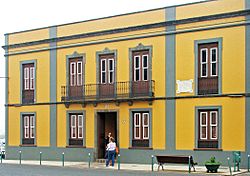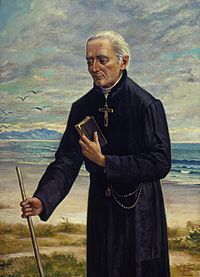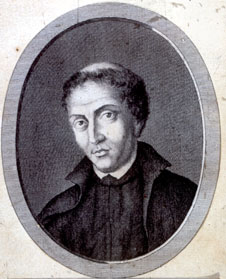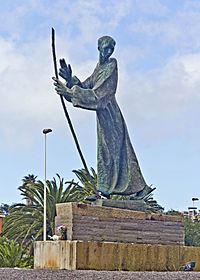Joseph of Anchieta facts for kids
Quick facts for kids SaintJoseph of Anchieta S.J. |
|
|---|---|
 |
|
| Apostle of Brazil Priest, Missionary, Religious |
|
| Born | 19 March 1534 San Cristóbal de La Laguna, Tenerife, Canary Islands, Spanish Empire |
| Died | 9 June 1597 (aged 63) Reritiba, Espírito Santo, Governorate General of Brazil, Iberian Union |
| Venerated in | Catholic Church (Brazil, Canary Islands, and the Society of Jesus) |
| Beatified | 22 June 1980, Saint Peter's Square, Vatican City, by Pope John Paul II |
| Canonized | 3 April 2014 (equivalent canonization), Vatican City, by Pope Francis |
| Major shrine | Cathedral of San Cristóbal de La Laguna (in Canary Islands) and National Shrine of San José de Anchieta (in Brazil) |
| Feast | 9 June |
| Attributes | Gospel Book, Crucifix and Cane |
| Patronage | Catechists, of those who suffer scoliosis and compatrono of Brazil |
José de Anchieta (born March 19, 1534 – died June 9, 1597) was a Spanish Jesuit missionary. He traveled to the Portuguese colony of Brazil in the 1500s. He was a very important person in Brazil's early history.
Anchieta helped found two major cities: São Paulo in 1554 and Rio de Janeiro in 1565. He was the first playwright, grammarian (someone who studies language rules), and poet born in the Canary Islands. Many people call him the "father of Brazilian literature".
He also worked to teach and convert the Indigenous people to the Catholic faith. His efforts, along with another Jesuit, Manuel da Nóbrega, helped create stable settlements in the colony.
Anchieta wrote a book called Arte de gramática da lingoa mais usada na costa do Brasil (1595). In this book, he created a way to write down the Old Tupi language. This was the main language spoken by the Indigenous people of Brazil.
People often call Anchieta "the Apostle of Brazil". Pope Francis made him a saint on April 3, 2014. He was the second person from the Canary Islands to become a saint.
Contents
Early Life in the Canary Islands
José de Anchieta was born on March 19, 1534. His birthplace was San Cristóbal de La Laguna on Tenerife in the Canary Islands, Spain. His family was wealthy. He was baptized on April 7, 1534, in a church that is now the La Laguna Cathedral. He lived in a house now known as Casa Anchieta until he was 14.
His father, Juan López de Anchieta y Zelayaran, was a landowner from the Basque Country. He moved to Tenerife in 1525 after a failed rebellion. Through his father, Anchieta was related to Ignatius of Loyola, who started the Society of Jesus (Jesuits). His mother, Mencia Díaz de Clavijo y Llarena, was from a family that had recently converted to Christianity.
When he was 14, Anchieta went to study in Portugal. He attended the Royal College of Arts in Coimbra. He was very religious and felt called to become a priest. At 17, on May 1, 1551, he joined the Jesuits at the University of Coimbra. He studied very hard and became ill, which caused a spine injury. He learned to write Portuguese and Latin, in addition to his native Spanish.
Missionary Work in Brazil
In 1553, the Jesuits sent Anchieta to the Portuguese colony of Brazil. They hoped the warmer climate would help his health. After a difficult journey and a shipwreck, Anchieta and his group arrived in São Vicente. This was the first village founded in Brazil in 1532. There, he met the Tapuia Indigenous people.
Later in 1553, Manuel da Nóbrega, the leader of the Jesuits in Brazil, sent Anchieta and 12 other Jesuits to a high plain. The Indigenous people called this place piratininga. It meant "drying fish" because many fish could be found drying there after floods. The Jesuits started a small mission settlement there. On January 25, 1554, they held their first Mass. This date is now celebrated as the founding of São Paulo.
Anchieta and his fellow Jesuits began teaching the native people about Christianity. They also introduced basic education. Anchieta taught Latin to the Indigenous people. He also started learning their language, Old Tupi, and began creating a dictionary and a grammar for it. Their mission, the Jesuit College of São Paulo, soon grew into a small town.
Anchieta and Nóbrega often disagreed with how Portuguese colonists treated the Indigenous people. However, they supported the Portuguese against the French, who also wanted to claim parts of Brazil.
Many Indigenous tribes along the coast formed an alliance called the Tamoyo Confederation. This was because Portuguese colonists were harming their villages and trying to enslave them. The Tamoyos then allied with French colonists who had settled in Guanabara Bay.
The Tamoyo Confederation attacked São Paulo several times. Anchieta and Nóbrega started peace talks with the Tamoyos. Anchieta's skill with the Tupi language was very important for these talks. After many challenges, they finally gained the trust of the Indigenous people. Peace was made between the Tamoyo and Tupiniquim nations and the Portuguese.
Portuguese and French conflicts started again. Estácio de Sá, a relative of the new Governor-General, was ordered to remove the French. With Anchieta's support, he founded Rio de Janeiro in 1565. Anchieta was there and helped in battles between the Portuguese and French. He worked as a surgeon and interpreter. He also reported back to the governor-general's office.
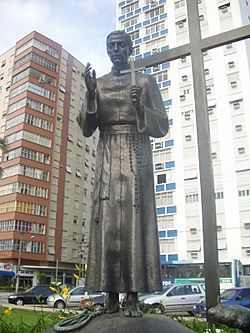
After peace was settled, a Jesuit college was founded in Rio. Anchieta took over its leadership when Nóbrega died in 1570. Despite his poor health, Anchieta traveled widely for ten years. He went between Rio de Janeiro, Bahia, Espírito Santo, and São Paulo. He worked to strengthen the Jesuit mission in Brazil. In 1577, he was appointed the main leader of the Jesuits in Brazil.
As his health got worse, Anchieta asked to be relieved of his duties in 1591. He died in Brazil on June 9, 1597. Over 3,000 Indigenous people mourned his death.
Anchieta's Written Works
Anchieta wrote many letters and reports to his superiors. These writings show him as an ethnographer, someone who studies cultures. He described the behaviors and customs of the Indigenous people. His detailed accounts are still used by experts today.
Anchieta was a pioneer in writing down the Old Tupi language. He wrote the first published book about it, a grammar called Arte de gramática da língua mais usada na costa do Brasil. This book was written in 1555 and published in 1589. His grammar and dictionary are still considered some of the best for a Brazilian language. His works in the Indigenous language include theology, religious lessons, plays, and poetry.
He was also a historian. He wrote a long poem about Mem de Sá, a governor of Brazil. This poem, De Gestis Meni de Saa, was the first epic poem about the Americas. His other major poem was De Beata Virgine Dei Matre, dedicated to the Virgin Mary. It is said that Anchieta wrote this poem while held captive in 1563. He wrote verses in the wet sand and memorized them. When he was freed, he wrote all 4,900 verses on paper.
Anchieta's plays were written in a mix of Tupi, Portuguese, Spanish, and Latin. They were performed by local people in village squares and churchyards. These plays taught Christian morals. They were often created for special events, like a saint's feast day. Scholars have noted that his plays included details about local events. Few of his plays still exist. However, they are praised for their use of costumes, songs, dances, and processions. Anchieta's play "auto da pregação universel" (1567) was the first dramatic text in Brazilian literature.
He was also a keen naturalist. He described many new plants and animals from Brazil's wildlife and geography. His clear and detailed reports are still important for understanding the beliefs and customs of people in the 1500s. He was also a skilled surgeon and physician.
His writings were collected in the 1730s for his beatification process. They were published as Cartas, Informações, Fragmentos Históricos e Sermões (Letters, Reports, Historical Fragments and Sermons).
Anchieta's Legacy
José de Anchieta is known as the founder of Brazilian literature. With Nóbrega, he is called the Apostle of Brazil. Two cities are named after him: Anchieta in Espírito Santo (where he died) and Anchieta in Santa Catarina. Many other places, roads, and schools also bear his name. A climbing plant of the Violaceae family was named Anchietea after him.
In 1965, the Spanish postal service released a stamp with Anchieta's image. This was part of a series called "The Founders of America."
A Brazilian movie about his life, Anchieta, José do Brasil, was released in 1977.
Becoming a Saint
When beatified by Pope John Paul II in 1980, Anchieta received the title "Blessed José de Anchieta." Pope Francis announced his canonization as a saint on April 3, 2014. This was done through a process called equivalent canonization. This process allows someone who has been honored for a long time to become a saint without the usual long ceremonies. Anchieta was the first Spaniard canonized by Pope Francis.
During and after his life, people thought José de Anchieta had special powers. Many stories grew around him. For example, it is said he once preached to and calmed an attacking jaguar. Even today, some people believe that praying to Anchieta protects against animal attacks.
José de Anchieta is highly respected in the Canary Islands. A bronze statue of him in San Cristóbal de La Laguna shows him leaving for Portugal. This statue was a gift from the Government of Brazil. A wooden image of him is also honored in the Cathedral of La Laguna. It is carried in a procession every June 9. In the Basilica of Candelaria, there is a painting of José de Anchieta founding São Paulo. A comic book about his life was published in 1997.
Patronage
José de Anchieta is the patron saint and a role model for catechists (people who teach about the Christian faith). Pope Benedict XVI also named him one of the thirteen helpers for World Youth Day 2013 in Rio de Janeiro.
In April 2015, the National Conference of Bishops of Brazil declared him a co-patron of Brazil. The main patron saint of Brazil is Our Lady of Aparecida.
Shrines in His Honor
The main shrines dedicated to Saint José de Anchieta are in places important to his life:
 Spain (Canary Islands): In San Cristóbal de La Laguna, his birthplace, the main shrine is the Cathedral of San Cristóbal de La Laguna. He was baptized here in 1534, and his image is honored there. Every June 9, flowers are placed at his bronze statue. A special Mass is held in the cathedral, followed by a procession with his image to his birthplace.
Spain (Canary Islands): In San Cristóbal de La Laguna, his birthplace, the main shrine is the Cathedral of San Cristóbal de La Laguna. He was baptized here in 1534, and his image is honored there. Every June 9, flowers are placed at his bronze statue. A special Mass is held in the cathedral, followed by a procession with his image to his birthplace. Brazil: The National Shrine of San José de Anchieta is in Reritiba (now called Anchieta) in the state of Espirito Santo. This shrine has an important museum of sacred art. It is built where he lived his last years and died. A national holiday for the saint is celebrated here with many people visiting from all over Brazil. After Anchieta was declared a co-patron of Brazil in 2015, this church became a National Shrine.
Brazil: The National Shrine of San José de Anchieta is in Reritiba (now called Anchieta) in the state of Espirito Santo. This shrine has an important museum of sacred art. It is built where he lived his last years and died. A national holiday for the saint is celebrated here with many people visiting from all over Brazil. After Anchieta was declared a co-patron of Brazil in 2015, this church became a National Shrine.
See also
 In Spanish: José de Anchieta para niños
In Spanish: José de Anchieta para niños
- List of saints of the Canary Islands
- Jesuit Reductions
- Colonial Brazil
- France Antarctique


